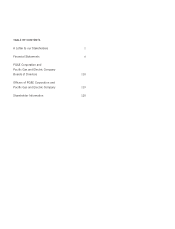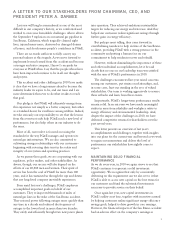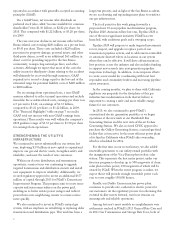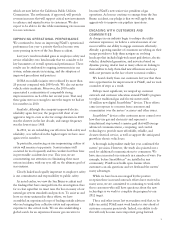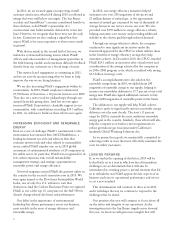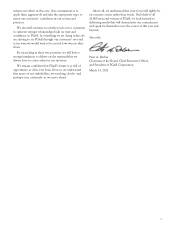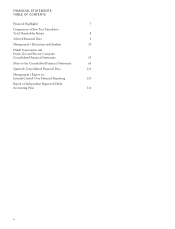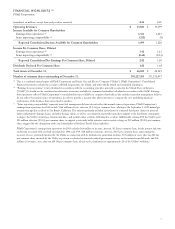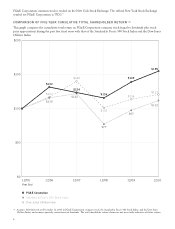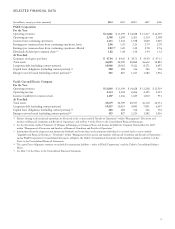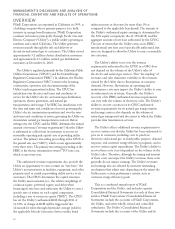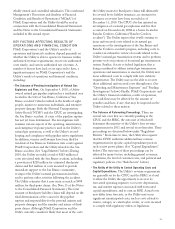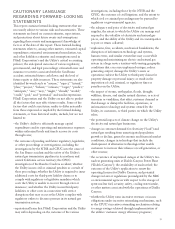PG&E 2010 Annual Report Download - page 7
Download and view the complete annual report
Please find page 7 of the 2010 PG&E annual report below. You can navigate through the pages in the report by either clicking on the pages listed below, or by using the keyword search tool below to find specific information within the annual report.which are now before the California Public Utilities
Commission. The settlements, if approved, will provide
revenue increases that will support critical new investments
to enhance and expand service to customers. We also
expect to be able to do this while minimizing rate increases
for our customers.
IMPROVING OPERATIONAL PERFORMANCE
We continued to focus on improving PG&E’s operational
performance last year—a priority that has become even
more pressing in view of the San Bruno accident.
Last year’s results included gains in employee safety and
service reliability—two benchmarks that we consider to be
key barometers of overall operational performance. These
results can be attributed to ongoing investments in our
system, enhancements in training, and the adoption of
improved procedures and practices.
OSHA recordable injuries were reduced by more than
20 percent compared with 2009 levels. We also cut motor
vehicle safety incidents. Moreover, the 2010 results
represented a continuation of comparably strong
improvements in each of the last several years. That said,
these gains were not enough to meet the targets we had set
for ourselves in 2010.
Similarly, although the company improved electric
reliability again last year, the progress fell short of our
aggressive targets—even as electric outage duration in 2010
was the shortest in the last decade, and outage frequency
was the lowest since 1988.
In 2011, we are redoubling our efforts in both safety and
reliability, as is reflected in the higher targets we have once
again set for ourselves.
In particular, reinforcing an uncompromising culture of
safety will remain a top priority. Serious injuries still
occurred far too frequently and two workers lost their lives
in preventable accidents last year. This year, we are
concentrating our attention on eliminating these most
serious incidents, with our eyes still on the ultimate goal of
zero injuries.
Closely linked and equally important to employee safety
is our commitment and responsibility to public safety.
As noted earlier, we view the San Bruno accident and
the findings that have emerged from the investigation thus
far as clear signs that we must raise the bar on many of our
natural gas system standards and practices. To assist us and
leave no stone unturned in these efforts, we have
assembled an experienced corps of leading outside advisors
who are bringing their collective safety and operations
expertise to this critical work. We are also undertaking a
global search for an experienced senior gas executive to
become PG&E’s new senior vice president of gas
operations. As lessons continue to emerge from the San
Bruno accident, our pledge is that we will apply them
aggressively to improve our pipeline operations.
ENGAGING WITH CUSTOMERS AND
COMMUNITIES
As changes in our industry begin to reshape the utility
customer experience, we believe a critical measure of our
success will be our ability to engage customers effectively.
Already, a growing number of consumers are relying on their
energy providers to help them navigate an evolving
landscape that includes high-tech smart grid devices, electric
vehicles, distributed generation, and new rates based on
dynamic pricing. And at least as many others are looking to
their utilities to help them find new efficiencies and cope
with cost pressures in the face of new economic realities.
We heard clearly from our customers last year that these
were opportunities for improvement at PG&E, and we took
a number of steps as a result.
Perhaps most significant, we ramped up customer
outreach and customer education around PG&E’s program
to replace traditional gas and electric meters with
10 million new digital SmartMeter™devices. These efforts
came in response to concerns from customers and
communities over the meters’ accuracy and other issues.
SmartMeter™devices offer customers more control over
how they use gas and electricity and represent a
foundational step toward a smarter grid that will leverage
advanced communications, computing, and control
technology to provide more affordable, reliable, and
cleaner electrical service, as well as support the anticipated
growth in electric vehicle use.
A thorough independent study last year confirmed the
meters’ precision. However, the study also pointed out a
need for additional communications to consumers. We
have since increased our outreach in a number of ways. For
example, before SmartMeters™are installed in any
community, PG&E now holds open forums where
customers can ask questions and see firsthand the meters’
many advantages.
While we have been encouraged by the positive
reception these increased outreach efforts have received in
many areas, we are committed to continuing to work with
those customers who still have questions about the new
technology as we work to complete the program by our
2012 target.
These and other issues last year underscored that, to be
fully successful, PG&E must work harder to stay ahead of
customer concerns proactively. Indeed, our ability to do
this will only become more important going forward.
3



